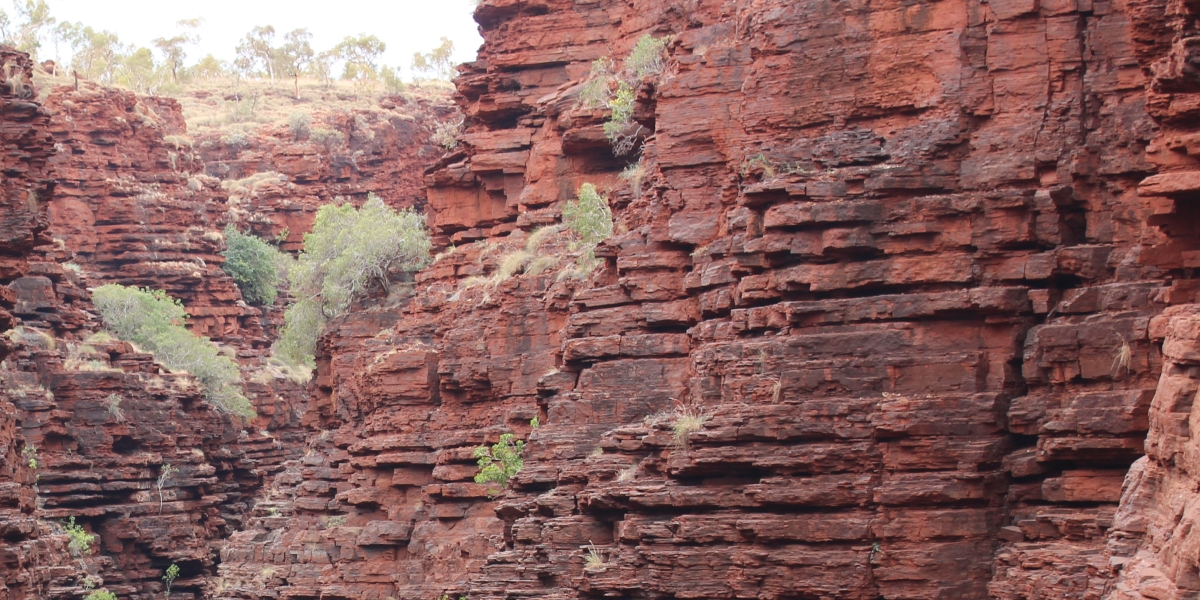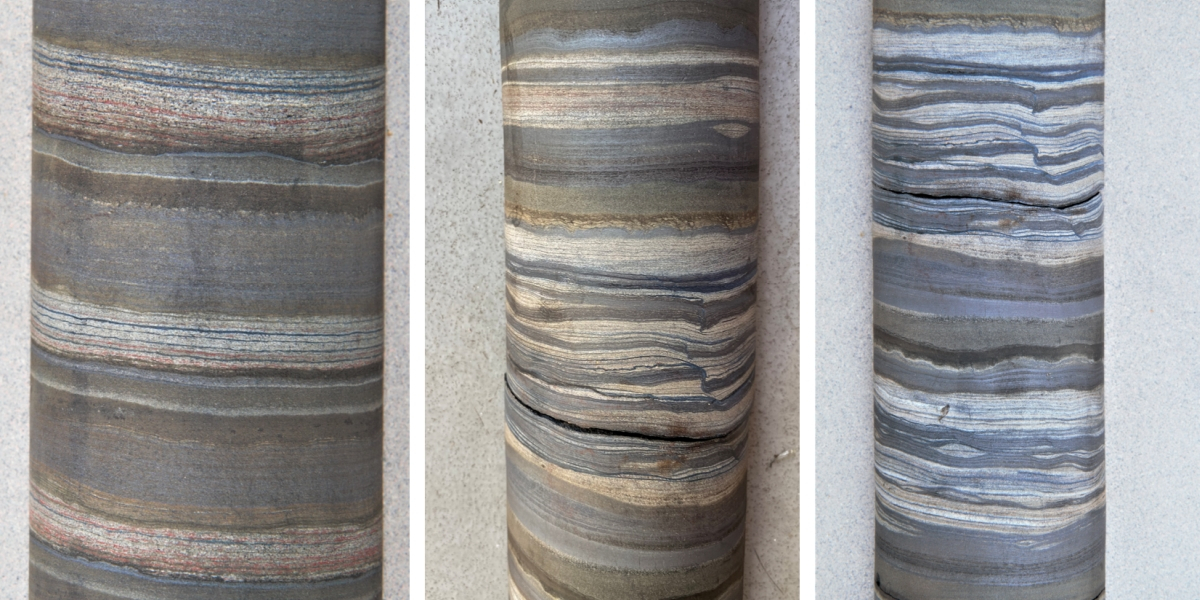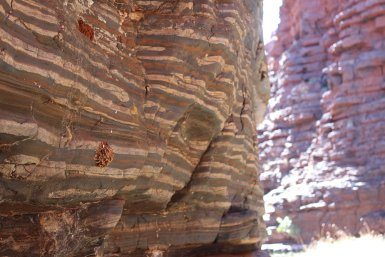Rise of oxygen in early ocean due to wobbling Earth's axis

~~ scroll naar beneden voor Nederlands ~~ for Dutch scroll down ~~
The sudden rise of oxygen
The "Earth System" worked substantially differently 2.5 billion years ago than it does today. The atmosphere was without oxygen and the oceans were rich in dissolved iron. Single-celled bacteria were the only inhabitants. That changed during the so-called "Great Oxidation Event. From about 2.4 to 2.2 billion years ago, in the geological blink of an eye, high levels of oxygen first entered the air and sea water; an event that was crucial to the further development of life on our planet.
Oxygen-free seas
NIOZ researchers' interest in oxygenless or oxygen-rich seas is not limited to the distant past, stresses NIOZ researcher Gert-Jan Reichart, who is also a professor of Marine Geology in Utrecht. "The research is also relevant today because we see oxygen-free zones forming in some parts of the ocean. Although the time scale is very different, the study of fluctuating oxygen levels in seawater from the distant past can give us insights that are useful to better understand the current increase in oxygen-free zones."
Bands of iron
During the study, Lantink and her colleagues looked at 2.46 billion-year-old earth layers in Australia. The pattern of regular "bands of iron" they found there appeared to match the rhythm of the earth's spinning and changes in its orbit around the sun. Those bands of iron in turn correspond to the coming and going of oxygen in the oceans.

Oxygen rose and fell
To understand how the pattern of iron deposits from Australia's ancient earth layers emerged, the researchers ran chemical model calculations on the 2.5 billion-year-old ocean floor. Lantink: "We found that periods of high bacterial growth were accompanied by the deposition of iron. The oxygen produced by the bacteria bound to iron, which was then carried away to the bottom as oxide. During periods with less bacterial growth, more iron remained dissolved in the water."
Wobbling Earth's axis
That coming and going of oxygen and of iron oxide (rust) on the ocean floor appeared to follow the pattern of the so-called Milankovitch cycles. Those cycles describe the variation of Earth's climate due to the wobbling of Earth's rotating axis. Also, the change in the shape of Earth's orbit around the sun is a rhythmically recurring process. During the period of the study, that "wobble" had a rhythm of 11 thousand years. Today, the Earth's axis wobbles back and forth at a rhythm of 21 thousand years.
Just the right time
This rhythm influences the Earth's climate, and consequently the coming and going of oxygen in the ancient oceans. "The pattern that became visible in Australia we also recognize in much younger earth layers around the Mediterranean Sea," says Reichart. "This research shows that just before the Great Oxidation Event, 2.5 billion years ago, astronomical conditions were apparently such that oxygen levels were occasionally raised over a threshold. At those times, so much oxygen was produced that the dissolved iron could no longer remove it all as rust to the sea floor."
Coincidence
That this confluence of circumstances occurred may seem like a great coincidence, but it is not. There had always been astronomical influence on Earth's climate. On the continents that had already formed by then, during wet periods, rivers provided runoff with many nutrients. These nutrients led to the recurring blooms of cyanobacteria in the oceans. The resulting production of oxygen eventually led to a huge increase in the Earth's oxygen content. And that turned out to be crucial for the development of complex life on Earth a short time later.
Toename zuurstof in vroege oceaan te danken aan wiebelende aardas
Zeeën op onze planeet bevatte bijna 2,5 miljard jaar geleden afwisselend meer of minder zuurstof. Dat komt door het langzame ‘wiebelen’ van de draaiende aarde. Dat schrijft een internationaal team van wetenschappers, deels verbonden aan de Universiteit Utrecht en het koninklijk Nederlands Instituut voor Onderzoek der Zee (NIOZ). “Dat de aarde uiteindelijk een zuurstofrijke planeet is geworden met een prettig klimaat, danken we mogelijk mede aan de juiste astronomische beïnvloeding op het juiste moment”, zegt de Utrechtse promovenda Margriet Lantink, eerste auteur van het artikel.
De plotselinge komst van zuurstof
2,5 miljard jaar geleden werkte het ‘Systeem Aarde’ wezenlijk anders dan vandaag de dag. De atmosfeer was zuurstofloos en de oceanen waren rijk aan opgelost ijzer. Eencellige bacteriën waren vrijwel de enige bewoners. Dat veranderde tijdens het zogenoemde ‘Grote Oxidatie Event’. Vanaf ongeveer 2,4 tot 2,2 miljard jaar geleden kwam er in een geologische oogwenk voor het eerst veel zuurstof in de lucht en het zeewater terecht; een gebeurtenis die cruciaal was voor de verdere ontwikkeling van leven op onze planeet.
Zuurstofloze zeeën
De interesse van NIOZ-onderzoekers in zuurstofloze of zuurstofrijke zeeën beperkt zich niet tot het verre verleden, benadrukt NIOZ-onderzoeker Gert-Jan Reichart, die tevens hoogleraar Mariene Geologie is in Utrecht. “Het onderzoek is ook vandaag relevant omdat we zien dat er zuurstofloze zones in sommige delen van de oceaan ontstaan. Hoewel de tijdschaal heel anders is, kan het onderzoek naar schommelende zuurstofgehaltes in zeewater uit het verre verleden ons inzichten geven die nuttig zijn om de huidige toename van zuurstofloze zones beter te begrijpen.”
Banden van ijzer
Tijdens het onderzoek keken Lantink en haar collega’s naar aardlagen van 2,46 miljard jaar oud in Australië. Het patroon van regelmatige ‘banden van ijzer’ dat zij daar vonden bleek overeen te komen met het ritme van de tollende aarde en veranderingen in de baan van de aarde om de zon. Die ijzerbanden hangen op hun beurt weer samen met het komen en gaan van zuurstof in de oceanen.

Komen en gaan van zuurstof
Om te begrijpen hoe het patroon van ijzerbandjes uit de oude aardlagen in Australië is ontstaan, lieten de onderzoekers chemische modelberekeningen los op de 2,5 miljard jaar oude oceaanbodems. Lantink: “We ontdekten dat perioden van veel bacteriegroei gepaard ging met het neerslaan van ijzer. De zuurstof die door de bacteriën werd geproduceerd, bond aan ijzer, dat vervolgens als oxide naar de bodem werd afgevoerd. In perioden met minder bacteriegroei, bleef er meer ijzer opgelost in het water zitten.”
Tollende aardas
Dat komen en gaan van zuurstof en van ijzeroxide (roest) op de oceaanbodem bleek het patroon te volgen van de zogeheten Milankovitch-cycli. Die cycli beschrijven de variatie van het aardse klimaat als gevolg van het heen en weer wiebelen van de draaiende aardas. Ook het veranderen van de vorm van de baan van de aarde om de zon is een ritmisch terugkerend proces. In de periode van het onderzoek had die ‘wiebel’ een ritme van 11 duizend jaar. Tegenwoordig wiebelt de aardas in een ritme van 21 duizend jaar heen en weer.
Precies het goede moment
Dit ritme beïnvloedt het klimaat op aarde, en daarmee dus ook het komen en gaan van zuurstof in de oude oceanen. “Het patroon dat in Australië zichtbaar werd, herkennen we ook in veel jongere aardlagen rond de Middellandse Zee”, aldus Reichart. “Dit onderzoek laat zien dat de astronomische condities vlak voor het Grote Oxidatie Event, 2,5 miljard jaar terug, blijkbaar zó gunstig waren, dat het zuurstofgehalte af en toe over een drempel werd getild. Op die momenten werd er zó veel zuurstof geproduceerd dat het opgeloste ijzer het niet allemaal meer als roest kon afvoeren naar de zeebodem.”
Samenloop van omstandigheden
Dat deze samenloop van omstandigheden optrad, lijkt misschien een grote toevalligheid maar is het toch niet. Er was altijd al astronomische beïnvloeding van het aardse klimaat. Op de continenten die toen al waren ontstaan, zorgden rivieren tijdens natte periodes voor afvoer van veel voedingsstoffen. Deze voedingsstoffen leidden tot de terugkerende bloei van cyanobacteriën in de oceanen. De productie van zuurstof die daarmee gepaard ging, heeft er uiteindelijk toe geleid dat het zuurstofgehaalte op aarde enorm toe nam. En dat bleek cruciaal voor de ontwikkeling van complex leven op Aarde, korte tijd daarna.
Other people
Publication
Precessional pacing of early Proterozoic redox cycles in Earth and Planetary Science Letters (March 2023).
Margriet L. Lantink, Wytze K. Lenstra, Joshua H.F.L. Davies, Rick Hennekam, David McB. Martin, Paul R.D. Mason, Gert-Jan Reichart, Caroline P. Slomp, Frederik J. Hilgen